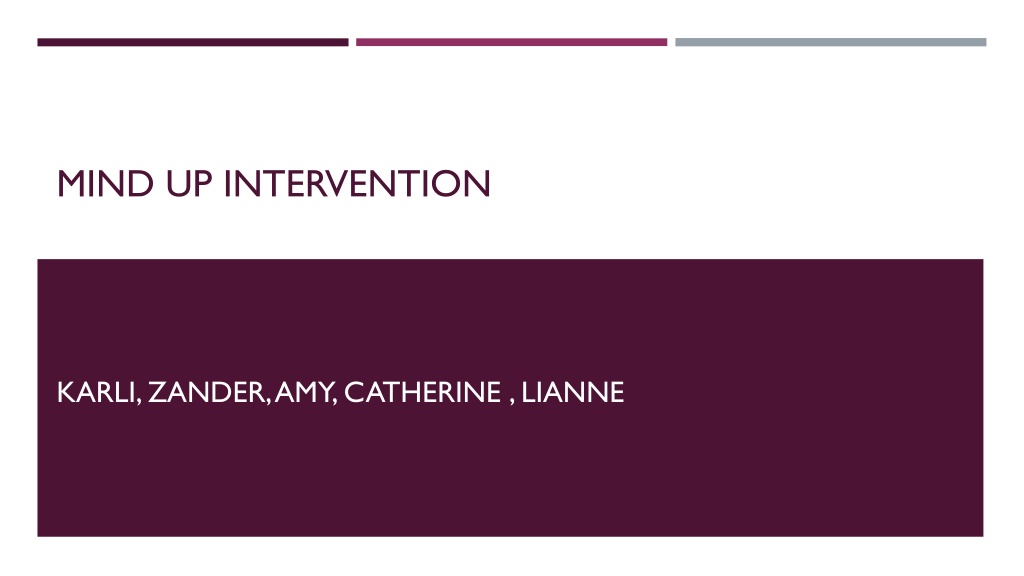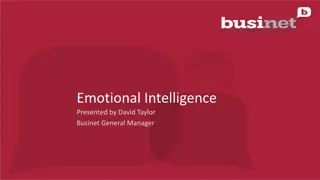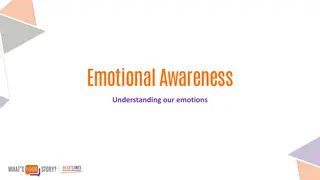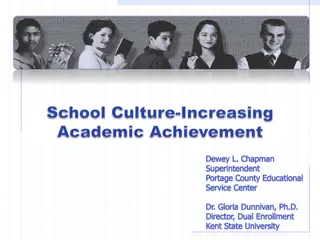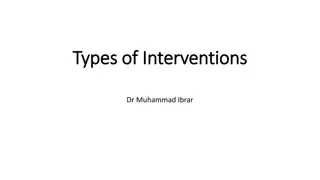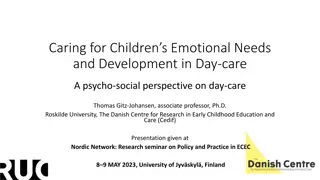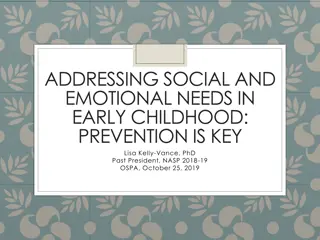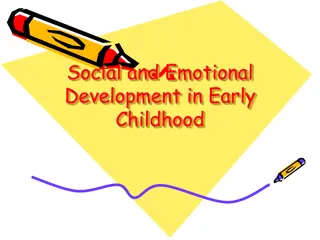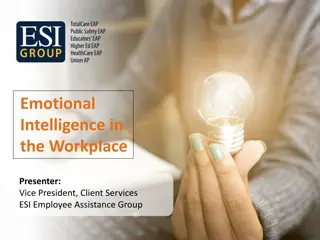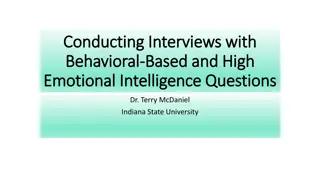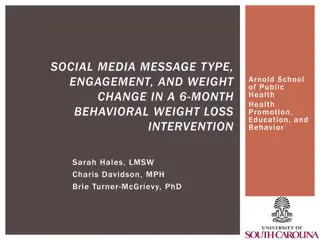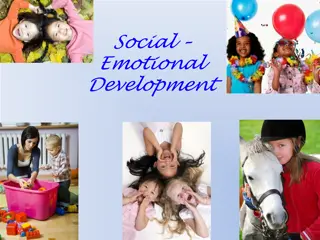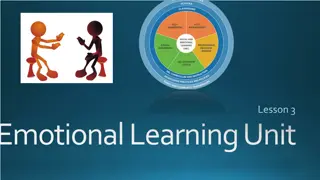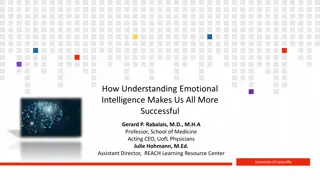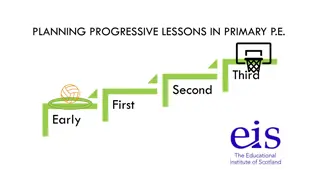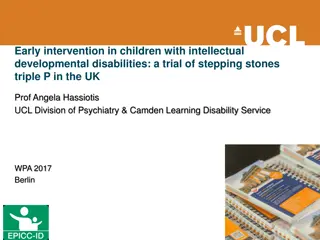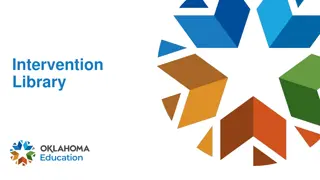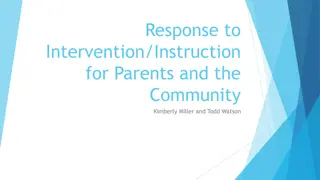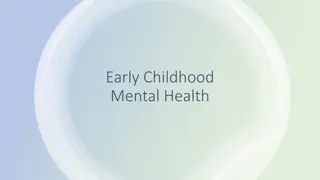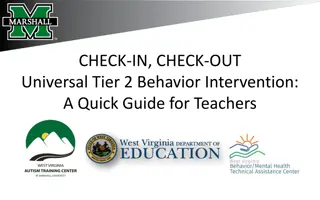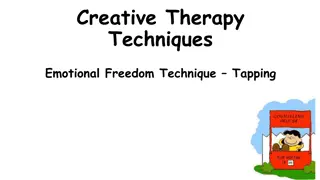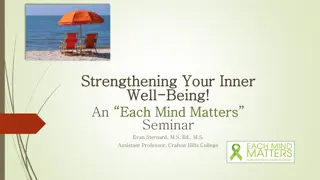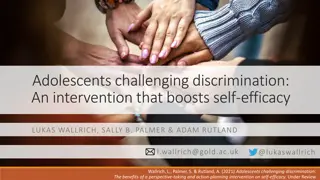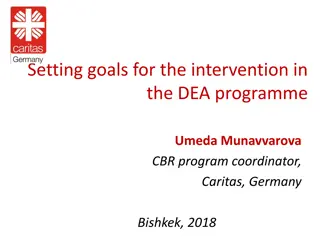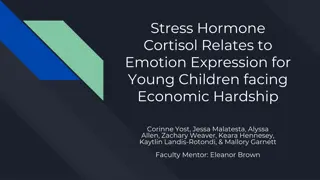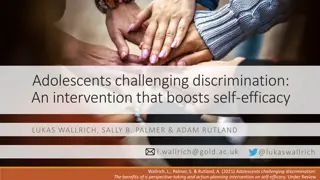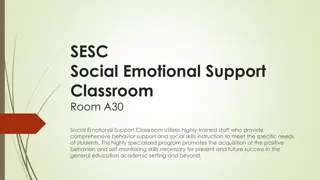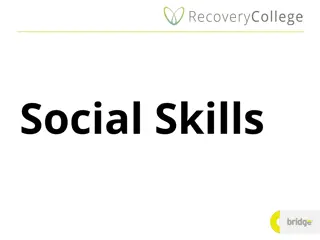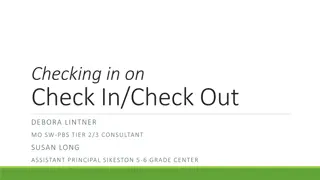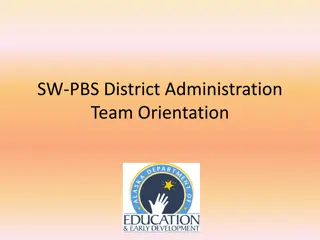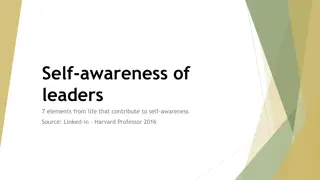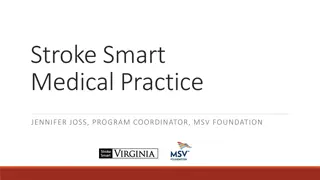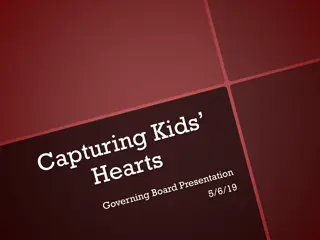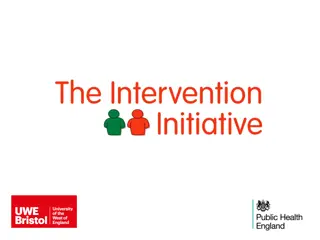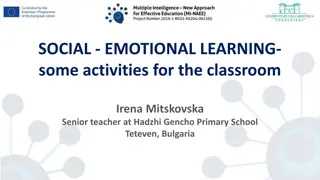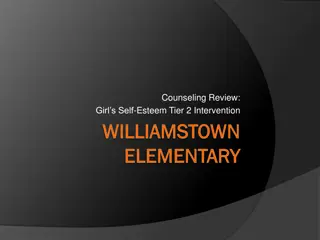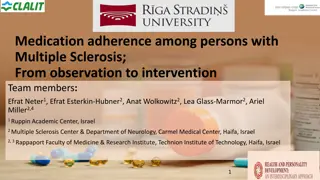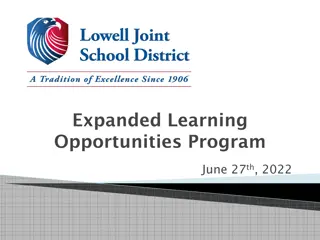Understanding the MindUP Intervention: Enhancing Social-Emotional Awareness and Academic Success
The MindUP Intervention is an evidence-based curriculum focused on fostering social-emotional awareness, enhancing psychological well-being, promoting academic success, and cultivating tolerance for differences. Through practices like deep belly breathing and attentive listening, students learn to self-regulate their behavior and respond reflectively. This approach is rooted in brain research and aims to empower students with valuable skills for emotional control and cognitive development.
Download Presentation

Please find below an Image/Link to download the presentation.
The content on the website is provided AS IS for your information and personal use only. It may not be sold, licensed, or shared on other websites without obtaining consent from the author. Download presentation by click this link. If you encounter any issues during the download, it is possible that the publisher has removed the file from their server.
E N D
Presentation Transcript
MIND UP INTERVENTION KARLI, ZANDER,AMY, CATHERINE , LIANNE
OUTLINE Description of the intervention Overview of Theoretical Basis Application Review of Research Basis Critical Thought
WELCOME TO MINDUP Imagine Imagine Imagine Joyful learning Academic Success Powerful sense of self and community Students who are engaged in a focused and energetic way with their peers, teachers and with their learning Students who see themselves as capable, self-aware human beings Compassionate, responsible citizens The Mindup Curriculum (2011)
DESCRIPTION OF THE INTERVENTION What is MindUP? Evidence-based curriculum framed around 15 lessons that foster: Social and emotional awareness Enhance psychological well-being The MindUp Curriculum Promote academic success An understanding of the brain Tolerance for differences The Mindup Curriculum (2011)
DESCRIPTION OF THE INTERVENTION How Does MindUp work? Repetition of the "Core Practice" Deep belly breathing Attentive listening Background Information on the brain Learning to Self-Regulate their own behaviour Learning to respond "Reflectively" instead of "Reflexively" The Mindup Curriculum (2011)
DESCRIPTION OF THE INTERVENTION: THE CORE PRACTICE Linking to Brain Research Controlling our breathing helps calm the body by slowing the heart rate, lowering blood pressure and sharpening focus Controlled breathing lessens anxiety by overriding the "fight, flight or freeze" response Neuroplasticity strengthens neuron connections through practice or repeated experience, reinforcing the habit of responding to anxiety by focusing on breathing The Mindup Curriculum (2011)
THEORETICAL BASIS The rationale Pillars Factors affecting change
THE RATIONALE MindUP aims to empower students to make their own choices and through mindfulness, become passionate and engaged learners and practice compassion and care to those around them. "I see children as bundles of pure potential and wanted to create a program that helped children to grow, learn and lead a very different kind of world Goldie Hawn ( The Hawn Foundation by Goldie Hawn, n.d.)
PILLARS Mindful Awareness Mindful Sensing Positive Mindset Mindful Actions (Hawn Foundation, 2011)
FACTORS AFFECTING CHANGE Awareness Attend in a non-judgmental way to personal physiological and emotional state Sensing Harness RAS to hone attention skills in order to build self-control and learning ability Positive Outlook Perspective taking, optimism and appreciation A perspective of happiness and appreciation has a multitude of benefits to self and others Mindful Action Build an empathetic outlook promoting mindful action to benefit others Being prosocial has societal and personal benefits (Hawn Foundation, 2011)
APPLICATION MINDFUL LISTENING (LESSON 4) Lesson 4 focuses on sensory awareness activities and RAS strengthening practice. Grades 6-8 version Introduction to lesson: Discuss the Reticular Activating System (RAS) "Attention-Focusing Centre" of the brain. Sorts sensory information and sends it to relevant areas of the brain, or blocks it. Trainable! RAS can become more effective.
APPLICATION MINDFUL LISTENING (LESSON 4) Goals of the lesson: Students able to train their attention on specific sounds and attempt to identify them. Students learn how mindful listening can help with communication. Materials: Objects to create sounds or sound effects from the Internet. Audio Alert/Present Scent Activity Sheet
APPLICATION MINDFUL LISTENING (LESSON 4) MindUp Warm Up: 1. Use a clapping and snapping rhythm for students to follow. 2. Ask students to come up with rhythms for the class to follow, increasing how difficult they are. 3. Break students up into groups of 6 to 10. Provide each group with a basic pattern. Ask them one at a time to vary the pattern and then have the other members copy it. Afterwards, discuss: How they kept track of the patterns. How this activity was similar/different to listening in class? How this activity was similar/different to listening to their friends?
APPLICATION MINDFUL LISTENING (LESSON 4) Audio Alert (Engage): "Let's consider why listening is important for school, for friendships & family, for pleasure (music) and for safety." "Do you think listening is a skill or a talent? What might be the difference?" "When there's lot's of noise around you, what do you do to help you pay attention to just one sound, like a friend's voice on a cell- phone call? What are some times when you are able to eliminate distractions and focus on a single important sound?" Then: Explain that the class will participate in an inquiry activity to develop mindful listening. "There are many sounds surrounding us most of the time. Usually we aren t mindful of every sound, because our brain helps us focus our attention by screening the sounds our ears pick up and bringing to our attention only the ones that are important. That filter in our brain is the Reticular Activating System (RAS). Listening mindfully can help us reinforce the work of the RAS.
APPLICATION MINDFUL LISTENING (LESSON 4) Audio Alert (Explore): Ask the students to sit quietly with their eyes closed. Say, "Listen as mindfully as you can to the sound I make and focus on it. If you think you know what it is, record your answer on the Audio Alert Activity Sheet." Make each sound, one at a time, and while giving students enough time to record their answers. Encourage them to be specific about the sound. Ask students to share their answers when the exercise is done. Reveal what each sound was. Then: Explain that, "by concentrating on specific sounds, you can train your RAS to listen carefully. That strengthens the pathways to the prefrontal cortex so you can get the information you're listening for more efficiently. You are more in control of your own thought processes if you are more aware of the constant sensory input that your brain experiences."
APPLICATION MINDFUL LISTENING (LESSON 4) Audio Alert (Reflect): Initiate class discussion and record responses on a large sheet of paper: "In what ways is this experience different from the way we typically listen to sounds? If you lost your focus on the sounds, explain what you think got in the way." "How might this kind of listening affect your brain?" "How was trying to identify sounds good practice for mindful listening?" Then: Explain that, "when you're really listening well, you get the information you need without being distracted. Then you can best decide how to respond."
APPLICATION MINDFUL LISTENING (LESSON 4) Continuing practice in Lesson 4 Options: Mind Up in the Real World Discuss careers that require mindful listening (ex. Doctors, 911 Operators, Customer Service Reps). Journal Writing: T-charts to show differences between mindful listening and everyday listening. Pick a word/phrase and listen mindfully for it during lunch. Explain why you think you did/did not hear it. Choose a class you have a hard time listening in and try to mindfully listen for the class period. How did you stay focused? What was your experience? Talk about a time you were a mindful listener and helped someone else. "Protect Your Hearing" - use a decibel meter to record how loud school sounds are (ex. Hallway during lunch, lockers closing). "What Sounds Similar in These Expression" - play the same expression in multiple languages and ask the students to listen for similarities. "Sounds Remembered" - Write sounds they associate with a list of words (ex. Anger, excite, agitate). "To Interview Is to Listen Well" - Have the students interview an important adult in their lives.
REVIEW OF THE RESEARCH BASIS MINDFULNESS Majority of the research on mindfulness is done on adult populations Meta-analysis on all published studies to date on mindfulness with youth (under 18) found a small to moderate effect size. Larger effect size in clinical populations suggesting that mindfulness is more effective in youth with psychopathology. Mindfulness in Youth particularly suited for mindfulness training due to qualities such as being open, ready to learn, and creative. Adolescence A window of opportunity Developmental plasticity in adolescences brains and in associated psychological and social-cognitive systems underlying development of psychosocial identity. Powers of self-reflection and social-perspective taking increase during this time.
REVIEW OF THE RESEARCH BASIS - SEL Research demonstrates that Comprehensive SEL-based prevention programming improves: Positive youth development: interpersonal skills, quality of peer and adult relationships, academic achievement and reduces problem behaviors. Mental Health: enhances competencies (I.e., assertiveness, communication skills, self-confidence, and reduces internalizing and externalizing problems. Substance abuse Anti-social behavior, school non-attendance and drug use Academic performance and learning
REVIEW OF THE RESEARCH BASIS - MINDUP RCT using the Mindup program Compared treatment using the Mindup program with "business as usual" (BAU) social responsibility program Focused on the late childhood period (grade 4 and 5) N=99 Examined group differences between treatment and BAU groups on a number of outcomes Executive Functioning (Flanker task, Hearts and flowers task) HPA regulation (diurnal cortisol levels) Social-emotional competence (child self-report measures, peer-report measures) End of year math grades
REVIEW OF THE RESEARCH BASIS - MINDUP RESULTS Results 24% gain in peer-nominated positive social behaviors a gain of 15% in math achievement a gain of 20% in self-reported well-being and prosociality and a reduction of 24% in peer-nominated aggressive behaviors ambiguous findings in regards to cortisol levels
EVIDENCE BASED INTERVENTIONS Strategies, practices, and programs for which research is available documenting their effectiveness (Rathvon, 2008) Practices informed by research, in which the characteristics and consequences of environmental variables are empirically established; relationship directly informs what a practitioner can do to produce a desired outcome (Dunst, Trivette, and Cutspec, 2002)
MIND UP INTERVENTION: CRITICAL ANALYSIS 1. Majority of research conducted with adult populations Does this limit the external validity of the results? 2. Meta-analyses supports a small to moderate effect size At what effect size is an intervention considered "successful"? 3.Intervention limited to classroom setting Do results generalize to wider population: school, home, community
MIND UP INTERVENTION: CRITICAL ANALYSIS 4. Effective for youth with psychopathology Is the intervention effective with typically developing youth? 5.Correlation vs. Causation Could changes be due to other, unrelated variables (e.g., maturation effects, placebo effect) 6.Fifteen lessons are structured and easy to follow (manualized treatment) Formal training required to ensure standardization (time, costs) Treatment fidelity
MIND UP INTERVENTION: CRITICAL ANALYSIS 7. No standardized measures for assessing program No way to accurately measure pre- and post- treatment results 8. Created in United States Canadian norms 9. Role of religion and moral teaching in schools Mindfulness has it's roots in Eastern religious practices "Letting go" emphasized vs. "Right vs. Wrong"
REFERENCES Dunst, C. J., Trivett, C. M., & Cutspec, P. A. (2002).Toward an operational definition of evidence-based practice.Centerscope, 1(1), 1 10. Frank, J.L., Jennings, P.A., & Greenberg, M.T. (2013). Mindfulness Based Interventions in School Settings: An Introduction to the Special Issue. Research in Human Development, 10:3, 205-210. doi: 10.1080/15427609.2013.818480 Greenberg, M. T., Weissberg, R. P., O Brien, M. U., Zins, J. E., Fredericks, L., Resnik, H., & Elias, M. J. (2003). Enhancing school-based prevention and youth development through coordinated social, emotional, and academic learning. American Psychologist, 58, 466 474. http://dx.doi.org/10.1037/0003-066X.58.6-7.466 Hawn Foundation. (2011). The MindUp curriculum. focused classrooms, mindful learning, resilient students. New York: Scholastic. The Hawn Foundation by Goldie Hawn. (n.d.). Retrieved from https://mindup.org/thehawnfoundation/ Rathvon, N. (2008). Effective school interventions: evidence-based strategies for improving student outcomes (2nd ed.). New York: Guilford Press. ISBN: 978-1572309678 Roeser, R.W., and Pinela, C. (2014). Mindfulness and compassion training in adolescence: a developmental contemplative science perspective. New Directions For Youth Development, 142, doi:10.1002/yd.20094 Schonert-Reichl, K. A., Oberle, E., Lawlor, M. S., Abbot, D., and Thomson, K. (2015). Enhancing cognitive and social emotional development through a simple-to- administer midfulness-based school program for elementary school children: a randomized control trial. Developmental Psyhcology, 51(1), 52-66. Zoogman, S., Golberg, S.B., Hoyt, W. T., & Miller, L. (2015). Mindfulness interventions with youth: a meta-analysis. Mindfulness, 6:290-302.
